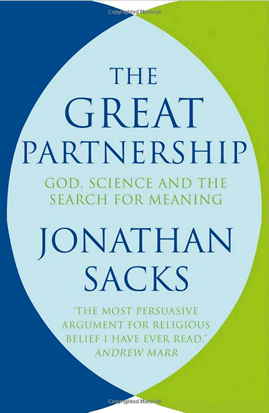Science takes things apart to see how they work, while religion puts things together to see what they mean.
 The great partnership; Science, religion and the search for meaning,
The great partnership; Science, religion and the search for meaning,
by Rabbi Jonathan Sacks
(Schocken Books, New York, 2011)
Rob Roi
In this book Rabbi Sacks believes we need all of our brain to understand and appreciate the world around us.
The left side of the brain associates mainly with scientific activity, while the right side of the brain is concerned with religion. While they must work in unison, they also need to be kept apart. The logic of one will not apply to the other.
In our age of information, it’s a challenge to keep the two separate but in balance. This is Sacks’ main theme throughout the book The Great Partnership.
He says science was born when people stopped telling stories about nature and started observing it — they stopped telling myths. He explains science takes things apart to see how they work, while religion puts things together to see what they mean.
I very much like Sacks’ last paragraph in the chapter “Why God?”
He states, “Religion and science, the heritage respectively of Jerusalem and Athens, products of the twin hemispheres of the human brain, must now join together to protect the world that has been entrusted to our safekeeping, honouring our covenant with nature and nature’s God — the God who is the music behind the noise; the Being at the heart of being, who’s still small voice we can hear if we learn to create a silence in the soul; the God who, whether or not we have faith in him, never loses faith in us.”
The Reverend Rob Roi is a parish deacon at St. James’ Dundas.
The difference between science and religion
Science takes things apart to see how they work, while religion puts things together to see what they mean.
by Rabbi Jonathan Sacks
(Schocken Books, New York, 2011)
Rob Roi
In this book Rabbi Sacks believes we need all of our brain to understand and appreciate the world around us.
The left side of the brain associates mainly with scientific activity, while the right side of the brain is concerned with religion. While they must work in unison, they also need to be kept apart. The logic of one will not apply to the other.
In our age of information, it’s a challenge to keep the two separate but in balance. This is Sacks’ main theme throughout the book The Great Partnership.
He says science was born when people stopped telling stories about nature and started observing it — they stopped telling myths. He explains science takes things apart to see how they work, while religion puts things together to see what they mean.
I very much like Sacks’ last paragraph in the chapter “Why God?”
He states, “Religion and science, the heritage respectively of Jerusalem and Athens, products of the twin hemispheres of the human brain, must now join together to protect the world that has been entrusted to our safekeeping, honouring our covenant with nature and nature’s God — the God who is the music behind the noise; the Being at the heart of being, who’s still small voice we can hear if we learn to create a silence in the soul; the God who, whether or not we have faith in him, never loses faith in us.”
The Reverend Rob Roi is a parish deacon at St. James’ Dundas.
The official communications channel of the Anglican Diocese of Niagara.
Keep on reading
Preaching as Spiritual Discipline: A Modern Challenge
Beekeeping Offers Insights for Healthy Parish Ministry
An Unexpected Journey to Becoming a Deacon
Coaching Helps Clergy Run the Race Well
Camp Gears up for a Summer of Memories
Wonder, Love and Prayer